
Photo editing is the secret ingredient that turns a good photograph into a masterpiece. It enables photographers to surpass the limitations of their cameras and bring their creative vision to life. Through photo editing, colors become richer, details sharper, and lighting more balanced. It bridges the gap between what the camera captures and what the human eye sees.
The process of post-processing isn’t about faking reality—it’s about perfecting it. Even the most skilled photographers use editing tools to correct exposure, color balance, and sharpness. These refinements add depth, dimension, and emotional impact to the image. With the right approach to photo editing, you can make your photos tell a story that feels alive and true to your artistic intent.
Essential Tools That Bring Photo Editing to Life
The heart of photo editing lies in the tools you use. Modern editing software gives photographers creative control over every pixel. Programs like Adobe Lightroom and Photoshop have become industry standards because they combine power and flexibility in a seamless manner. Lightroom streamlines your workflow and helps maintain consistency across your entire collection. It’s ideal for adjusting exposure, white balance, and contrast while preserving image quality.
Photoshop, on the other hand, provides precise control over layers, masks, and complex compositions. It’s perfect for retouching portraits, removing distractions, and creating digital artistry. Tools like Affinity Photo and Capture One also deliver professional-level results, each with unique strengths. Affinity Photo offers affordability without compromising features, while Capture One is renowned for its exceptional color accuracy and tethered shooting capabilities.
Even mobile photo editing apps like Snapseed, VSCO, and Lightroom Mobile empower photographers to create professional edits directly from their phones. The important thing isn’t which tool you use—it’s how well you understand photo editing principles. Every platform offers a unique way to shape light, color, and tone to suit your creative vision.
Mastering the Art of Photo Editing Techniques
Photo editing is an art form that requires both precision and creativity. Each adjustment you make helps reveal the full potential of your image. Adjusting exposure and contrast ensures that your photo has balanced brightness and strong visual depth. When exposure is corrected properly, highlights glow naturally while shadows retain texture.
Color correction and white balance adjustments define the mood of your image. Cool tones evoke a sense of calmness, while warm tones create a feeling of energy or nostalgia. Mastering color harmony enables you to convey emotion through your photos.
Composition refinement through cropping is another essential part of photo editing. A well-cropped image draws the viewer’s attention exactly where you want it. You can remove distractions and strengthen your subject by aligning the frame with natural focal points.
Sharpening and noise reduction also play crucial roles. They enhance clarity and reduce grain without losing detail. Overdoing these edits can make a photo look artificial, so subtlety is key.
Retouching adds finesse to your work, whether it’s removing blemishes from a portrait or removing unwanted objects in a landscape. Healing and cloning tools help perfect your images without compromising realism. Finally, filters and presets offer a creative shortcut, enabling you to maintain a cohesive style. However, remember that presets are starting points. Personalized adjustments are what make your photo editing unique and professional.
Finding Balance Between Creativity and Realism
In the world of photo editing, balance is everything. The goal is to enhance, not deceive. For documentary or journalistic photography, the goal is to remain faithful to reality, ensuring authenticity through minimal post-production adjustments. Simple exposure and color corrections usually suffice.
Artistic photography, however, thrives on creative freedom. Post-processing becomes a form of expression that allows you to play with surreal tones, dramatic contrasts, and imaginative effects. By experimenting with color grading or lighting enhancements, you can evoke mood and emotion that the original shot might have lacked.
Yet, even in creative photo editing, restraint matters. Over-saturated colors, extreme contrast, or over-smoothed skin can quickly make an image lose its natural appeal. The best edits are often invisible—they draw attention to the subject, not the technique.
Your goal as a photo editor is to make every adjustment purposeful. Each change should bring your audience closer to the feeling you want to convey. When your viewers are captivated by the story your image tells, without being distracted by the process behind it, that’s when you’ve mastered the art of photo editing.
Bringing Your Vision to Life Through Photo Editing
Photo editing isn’t just a technical step—it’s a creative journey. It gives you the power to refine light, enhance color, and guide emotion. Each edit adds dimension and depth, transforming your image into something that resonates with your audience. Whether you’re fine-tuning a portrait, crafting a moody landscape, or polishing a commercial shot, your edits define your style and artistic identity.
In today’s digital landscape, where visuals dominate, learning photo editing is essential for every photographer. It separates the amateur from the artist and allows your unique perspective to shine. The camera captures moments, but photo editing gives them soul.
Every masterpiece begins with a vision. Through thoughtful post-processing, that vision becomes reality. So open your favorite editing software, explore new techniques, and let your creativity shape every pixel. With passion, patience, and practice, your journey in photo editing will turn ordinary images into extraordinary works of art.